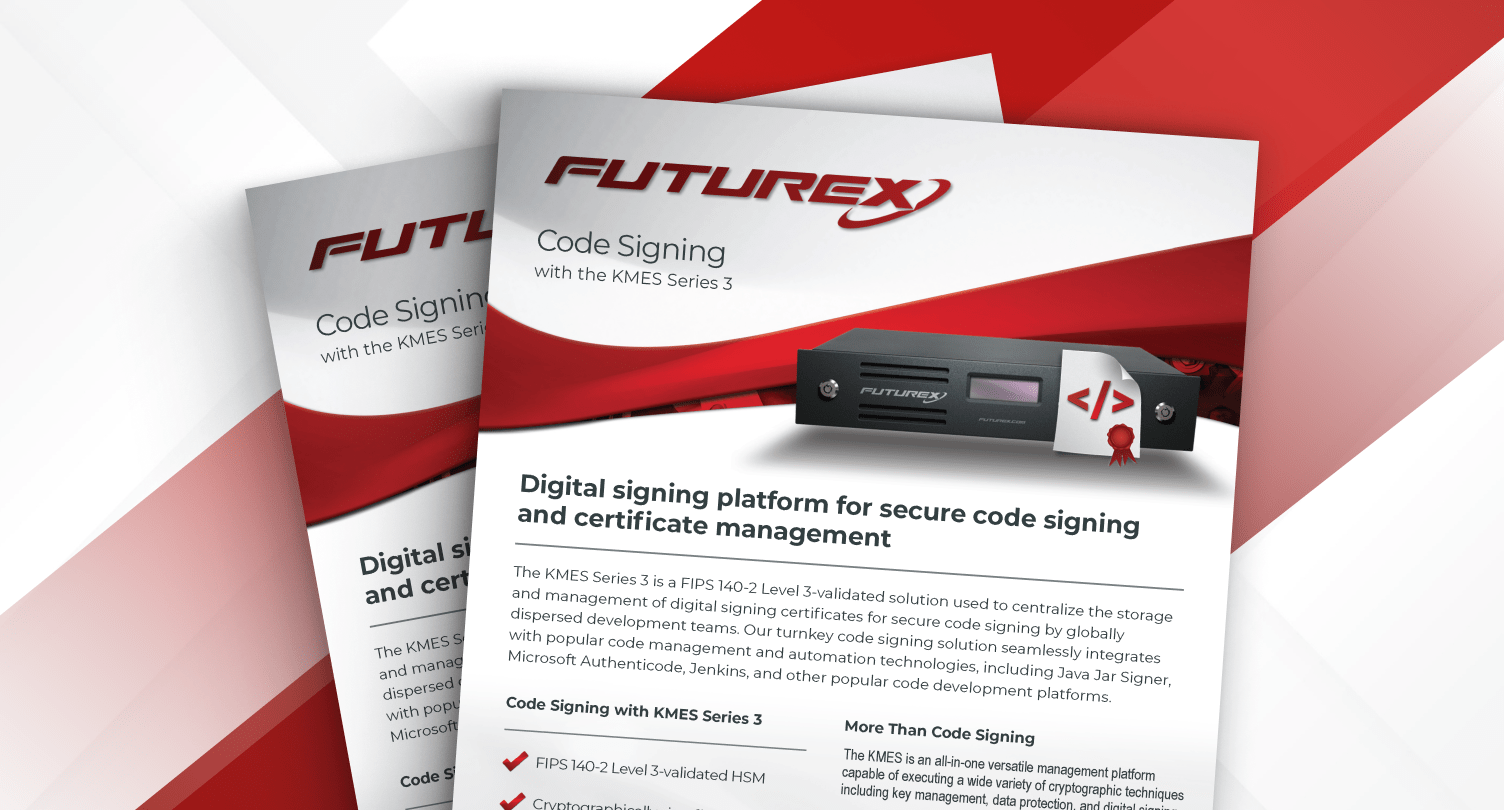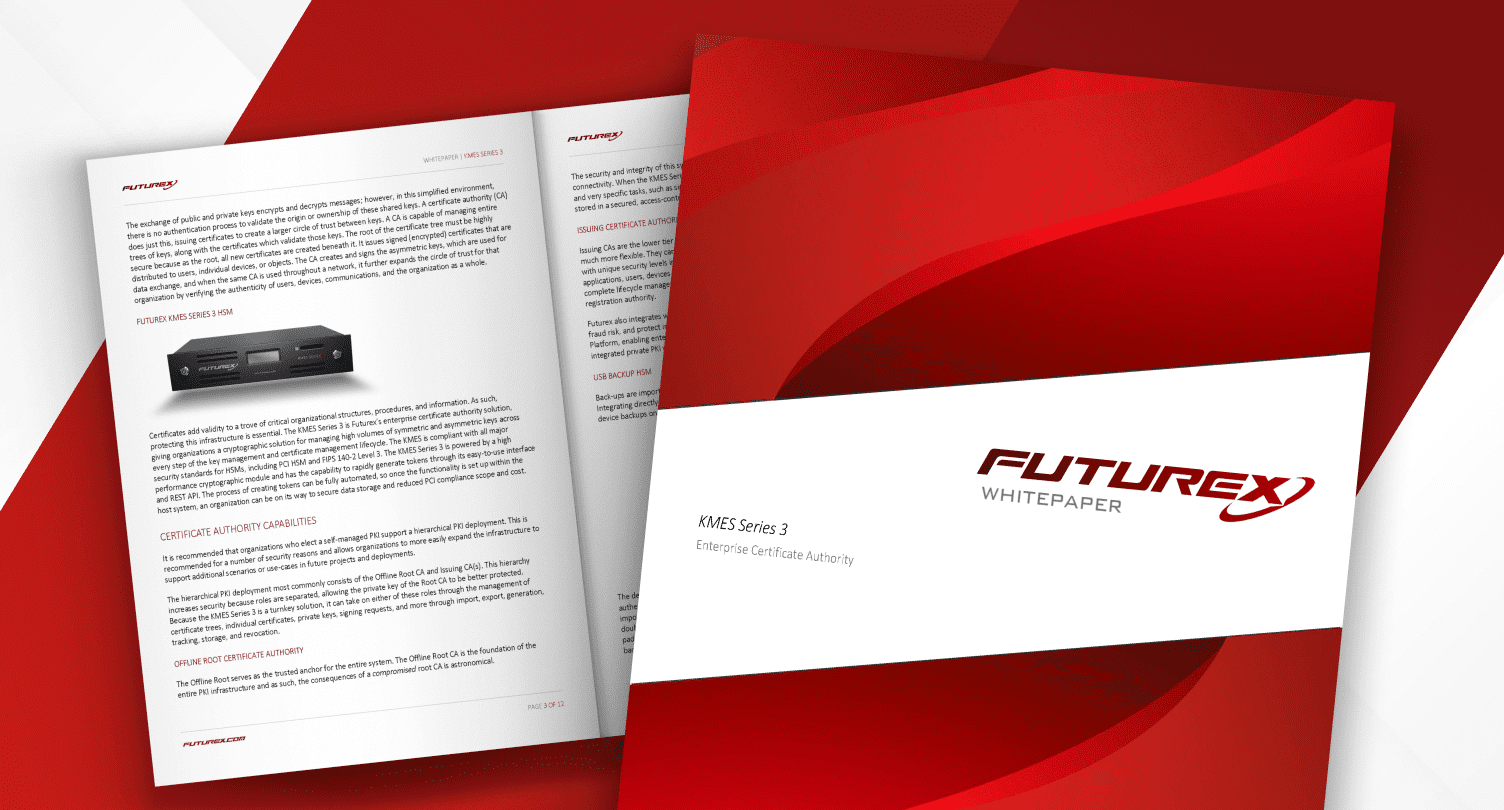Automotive Cybersecurity Regulations
Connected vehicles must be protected from cyber threats. Regulations like the USDOT’s Automated Vehicles Comprehensive Plan were developed for this purpose.
Data protection, from the individual parts up to the enterprise

Vehicles have become safer and easier to drive thanks to the automotive industry’s use of smart technology. But as vehicles become more sophisticated, threats to their security become more complex.
Futurex gives organizations the comprehensive and layered approach they need to protect passengers, secure critical operating data, expand revenue-generating services, and comply with new regulations.
Connected vehicles receive data such as weather information, security patches, and the speed of other vehicles. Manufacturers must secure each point of connectivity, from the manufacturing floor to the road. They perform the following tasks:
Futurex HSMs are available both on-premises and in the cloud. Industry-leading encryption and key management systems provide a foundational layer of security and trust between vehicular electronic control units (ECUs) and backend infrastructure. Futurex solutions enable you to do the following functions:
Increased vehicular communication means an increased number of data endpoints. Those endpoints, as well as the numerous electrical control units (ECUs) that support them, must be properly secured to safeguard passengers and to satisfy security regulations.
Futurex provides industry-leading key management solutions to secure endpoints within connected vehicles. This allows for mutual authentication between endpoints, object signing, increased automotive cybersecurity, and more.
Vehicle-to-everything (V2X) communication continues to advance, with connected vehicles accessible through mobile apps. Advanced V2X abilities pose both security risks and opportunities for providers.
Futurex’s solution suite involves fully validated hardware security modules (HSMs) and key management servers (KMSs). Providers use these for encryption and to develop a PKI, paving the way to a future of effective key management, cybersecurity, and the expansion of in-demand services.
Innovations in speed, safety, and comfort defined the automotive industry's past. But the present is more complex, with autonomous vehicles on the rise.
Companies must use advanced cybersecurity to protect connected vehicles, parts, and drivers. Especially as cars reach higher levels of automation.
Connected vehicles must be protected from cyber threats. Regulations like the USDOT’s Automated Vehicles Comprehensive Plan were developed for this purpose.
Modern cars contain hundreds of electronic control units (ECUs). These can exchange data like speed and direction with other connected vehicles to prevent collisions.
Increased vehicular connectivity and autonomy require back-end data protection to mitigate concerns about hackers, cyber-attacks, and other cyber security incidents.
Futurex object signing ensures the secure connectivity of data between two endpoints. It allows automotive companies to send focused software and firmware updates to road vehicles both in production and on the market.
Signing denies hackers attempting to import, load, or alter the car’s software code. The vehicle’s cyber security features actively reject changes not from the authorized parent source, thus ensuring security against any cyber attack.
You can also use object signing for parts verification. For example, you can digitally sign car batteries, one of many components at risk of being counterfeited, on the manufacturing floor.
Other components, such as electronic control units, can also be guarded against cyber attacks with digital signatures. These signatures cannot be replicated, protecting the brand and customers from dangerous counterfeits.
A car does not inherently know its owner. It responds to the physical key. Multi-factor authentication adds additional cyber security when verifying end-users. After implementation, it enables passenger cars to protect themselves by rejecting commands from fraudulent users.
There are three ways of identifying automotive users: with something users know (such as a password or PIN), with something users have (such as a smart card or token), or through something users are (such as biometrics: retina scanning, voice recognition, fingerprint scanning, and so on).
The development of multi-factor authentication adds an extra layer of automotive cybersecurity when verifying the customer’s identity by combining two of these categories. Futurex provides the foundational PKI necessary to identify end-users in this way.
Current Advanced Driver Assistance Systems and upcoming vehicles with SAE levels 3 and above require data sharing to function properly. Thus, automotive cyber security is essential, making it a major safety concern of compliance regulators.
V2I gathers necessary global or local information, such as traffic or road conditions, to intelligently lead a car to its destination. It gathers this information remotely, typically through a Wi-Fi connection and from a substantial distance.
With secured V2I, hackers seeking to eavesdrop or interfere with automotive systems are denied.
V2V occurs when vehicles are in close range and can establish ad-hoc networks. They can share the speed, position, and direction, necessary for autonomous driving.
Open networks such as these require encryption and data protection so that drivers don’t accidentally share malicious software code.
V2D describes the connection between unsecured mobile devices and connected cars for remote monitoring and access.
With V2D in place, drivers can remotely access their cars from smartphones, using certificate-based mutual authentication.
Futurex offers small, form factor hardware security modules that guarantee complete cyber security for automotive needs.
You can embed the ESM1000, designed for widespread environments, directly into vehicles on the production line. This tamper-resistant device prevents unauthorized access to the core functionality and electronics of the vehicle it is embedded in.
Like all Futurex devices, it provides maximum automotive cybersecurity and compliance by design.
With cryptographic tools embedded within vehicles, your business can make use of advanced key lifecycle management for over-the-air rotation.
With such a process in place, your company is secured and able to pursue revenue-generating practices such as tracking vehicle rentals and facilitating remote purchase upgrades.

Take advantage of an all-in-one solution to guarantee the integrity of your PKI with a secure, offline root CA.
Protect an issuing CA by using hardware-based key management solutions with PKI functionality and third-party integration.
Create a CA and PKI to secure your IoT devices from the floor or the field with digital certificates and signatures.
Securely distribute code and establish trust between apps with on-premises and cloud HSMs and turnkey solutions.
"When we have the right partners, we can help our customers overcome their challenges. ...which is why we are working with AWS and Futurex. They help us provide the innovative, scalable, reliable, and compliant solutions our customers are seeking day after day."
- Thiago Lopes, Information Security Manager
Pismo



Futurex provides HSMs and key management servers that handle encryption, bring-your-own-key (BYOK). Futurex helps enterprise organizations deploy a modern cloud data security environment that complies with the latest standards and regulations.

